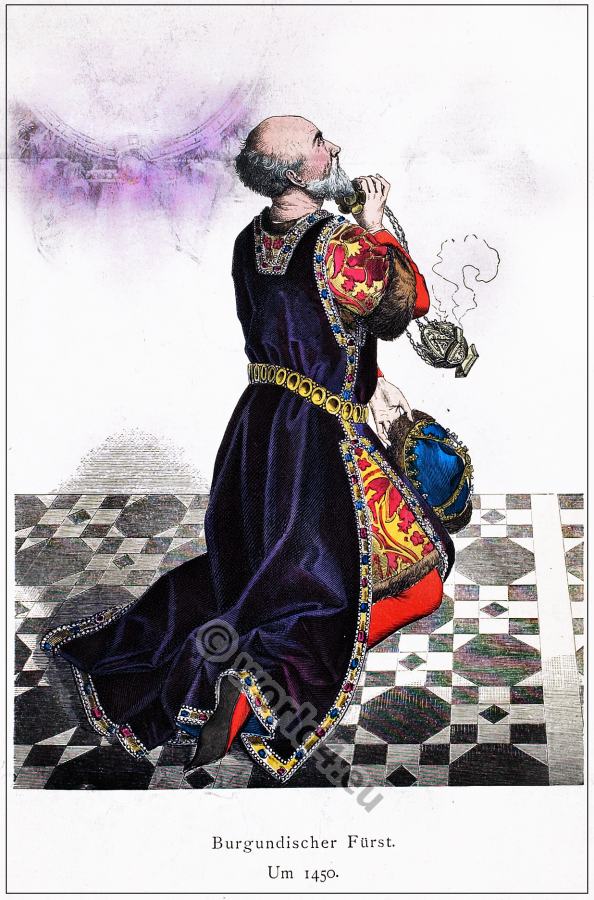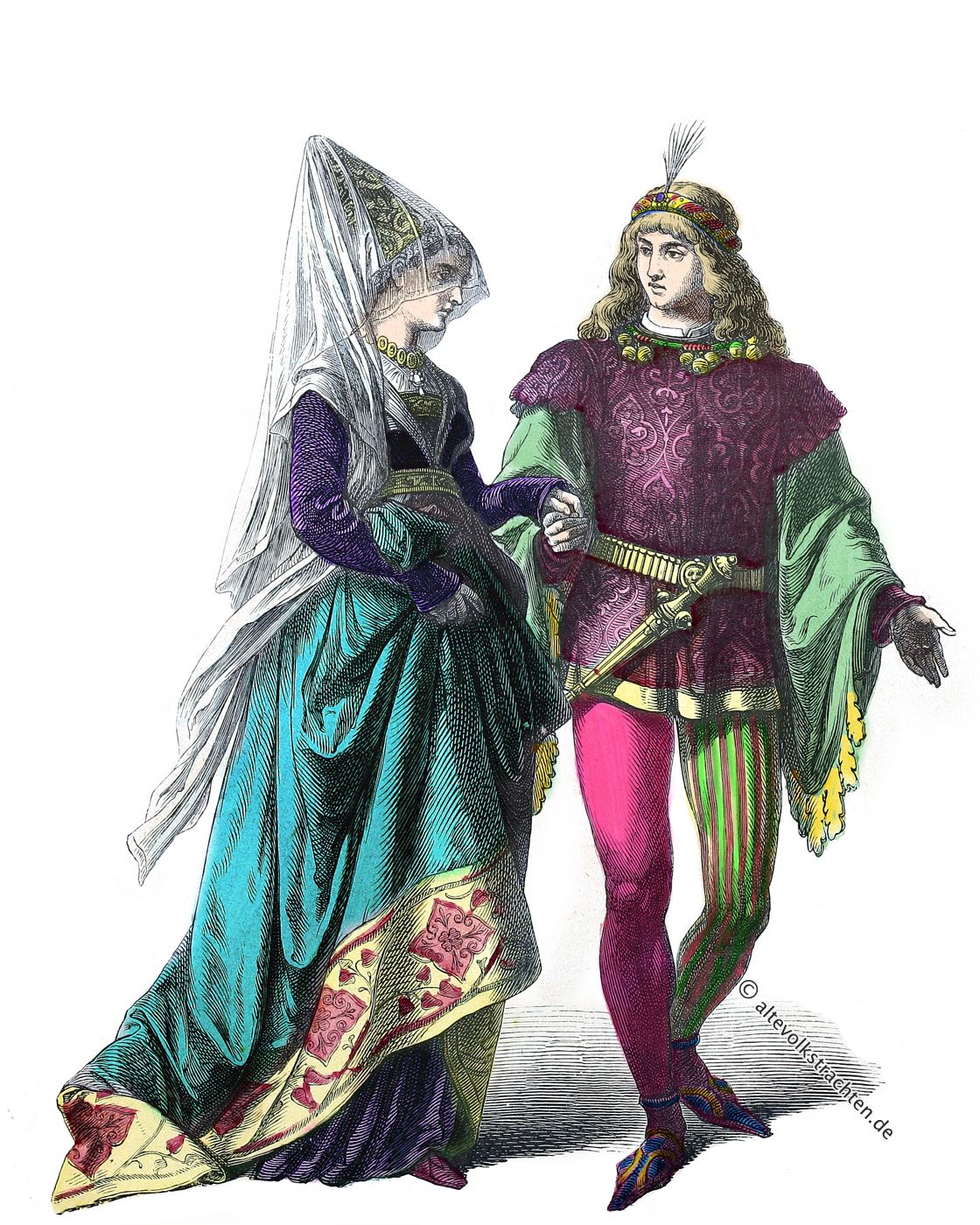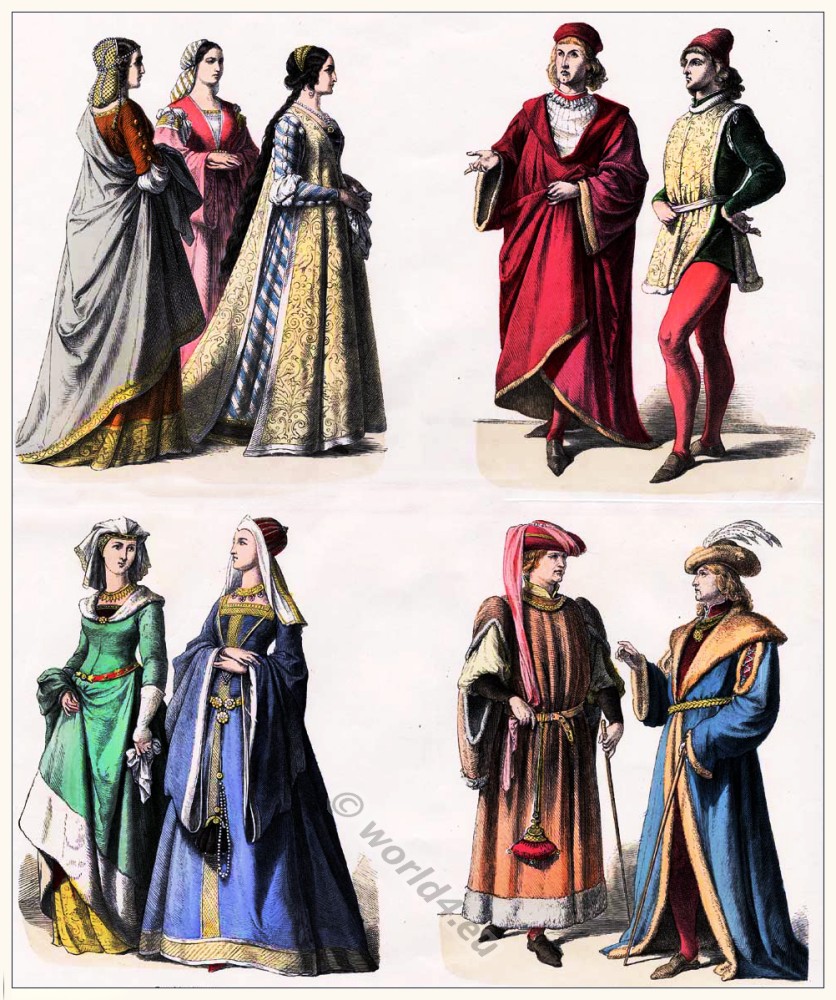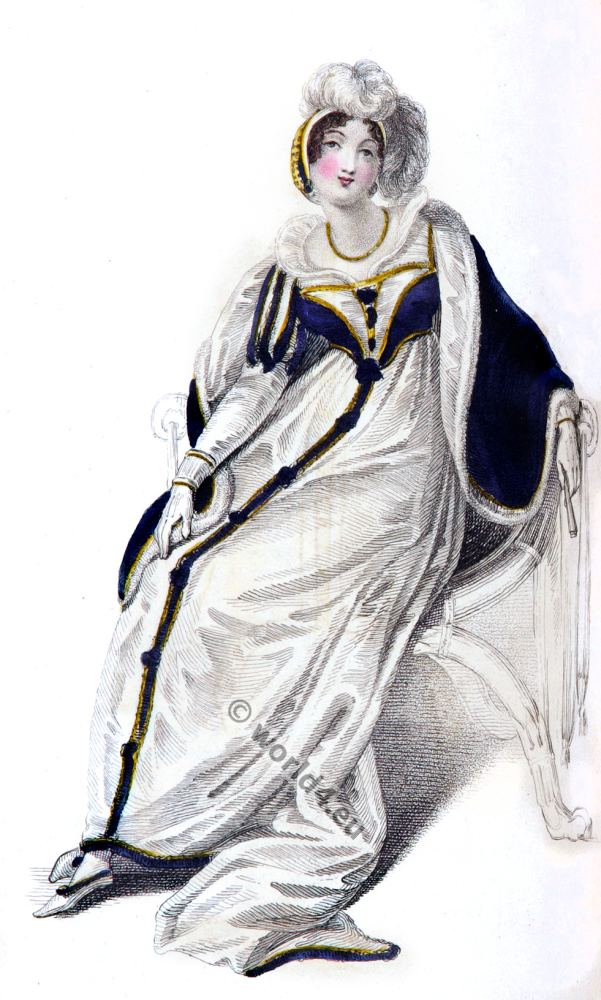Jack Cade and his insurrection.
Jack Cade, assuming the name John Mortimer; (died July 12, 1450 in Heathfield, East Sussex) was an English rebel against the policies of Henry VI, which contributed to the breakdown of royal authority, that led to the Wars of the Roses (1455–85) between the houses of York and Lancaster. He appeared to history out of nowhere in the spring of 1450 and led an army against London. After the capture and sack of London, the rebels were defeated and dispersed in a battle at London Bridge.
The admission of burgesses to parliament at the instance of Simon de Montfort in the reign of Henry III.; the codification and just settlement of the laws relating to individual freedom in pleading at the courts, effected by Edward I.; and, finally, the growth of liberty by the teaching of such men as Wycliffe, who led the people to question the authority of the clerical magnates, just as Thomas a Becket had claimed the support of the popular voice in defying the demands of the nobles of the court,— were the influences which led to the extension of national independence. With regard to the effects of the laws established by the Great Edward, who has been rightly designated the English Justinian, they fitly succeeded the provisions previously made for giving the people themselves a voice— however little may have been its authority — in the legislation of the country. “From the reign of Henry III.,” says Hallam, “at least the legal equality of all ranks of freemen below the peerage was for every essential purpose as complete as at present. … What is most particular is that the peerage itself imparts no privilege except to its actual possessor. The sons of peers are commoners, and totally destitute of any legal right beyond a barren precedence.” Unhappily though this was the theory of the law the tyranny of the rulers who succeeded Edward kept its practice in abeyance, while the whole nation was harassed beyond endurance; and the revenues were maintained by a brutal system of imposing and collecting the taxes which at last roused the people, and especially the peasantry, to a pitch of fury. The peasantry indeed had been gradually emerging from slavery to freedom, and the system of villeinage was dying out, not only in England but in Flanders, where many of the burghers made common cause with them; and in France, where the Jacquerie had set up a series of horrible cruelties during the attempt at insurrection, the lower classes of the population were making wild and often terrible efforts to achieve freedom from that degraded and brutalized condition to which they had been consigned by their rulers.
These causes, combined with the arbitrary tyranny with which the taxes were imposed, led, as we all know, to the insurrection that in the reign of the youthful Richard II. found its leader in Wat Tyler. Similar conditions excited by the efforts of the nobility again to reduce the people to vassalage, produced the revolt which seventy years afterwards found its representative in Jack Cade. At that time England had begun to lose under Henry VI. (King Henry VI. and his court. The good duke Humphrey.) all the prestige which his predecessors had gained by their conquests in France. It was proposed by the court to supplement the deficiencies of a king who was unfit to govern, by marrying him to a queen whose ambition it was to tyrannize. The council chose Margaret of Anjou, and the Earl of Suffolk gave force not only to the wish of the council but to the attempts of the queen to monopolize the whole authority of the government. Between them they ruled England, and compassed the destruction of Humphrey, duke of Gloucester, and his wife Eleanor Cobham, who was tried and condemned to perpetual imprisonment on a charge of necromancy against the king. Thus they played into the hands of the French monarch, till the whole of Normandy was lost, and it seemed as though England would itself be ceded as an appanage of the crown of France.
This was too much for the spirit of the English parliament, where at length the minority which had ventured to raise a cry against the despotism of the queen and her adviser grew into a majority, the complaints of which were echoed by a popular clamour, that was not easily silenced even by the impeachment and subsequent temporary banishment of “the queen’s darling.” Insurrections had broken out in several parts of the kingdom before the fall of the Duke of Suffolk, and the public discontent was augmented by the burden of taxes imposed upon the people and the infamous extortions practised by sheriffs and their collectors. At the time when the excitement against the government was at the highest there appeared in England a man named John Cade, who was a native of Ireland, whither he had returned after having been for some time in France—either as a soldier or an outlaw, a point upon which authorities are divided. Ireland was at that time governed by the Duke of York, and when Cade appeared under the name of Mortimer at the head of an insurgent army, and claimed a descent which made him a relation (though illegitimately) of the duke, there were not wanting declarations that the latter had employed this man in order to prepare the way for him in assuming the crown. There is little if any evidence of the truth of such an accusation, but it cannot be denied that the insurrection, by weakening the government, forwarded the expectations of the duke at that time.
Suffolk was dead. On the day that he was liberated, in order that he might quit England, a furious mob of 2000 persons assembled to assail him, but he contrived to evade them and to reach his estates, whence he travelled to Ipswich, and there embarked for the Continent with his retinue. Between Dover and Calais the course of two small vessels which he had engaged was arrested by a great ship of war, and the duke was ordered to go on board. As he stepped upon the deck the captain accosted him with the words “Welcome, traitor!” For two days he was detained on board, and probably foresaw that he was to die, for he was most of the time with his confessor. On the third day a cock boat came alongside, and in the boat was an executioner with block and axe. Suffolk was delivered to this man, who struck off his head, and his body was discovered on the beach near Dover. No investigation was made into the circumstances of his death, at which the people rejoiced with a kind of fierce exultation that may explain the tumults that followed and those subsequent wars of the Roses which afterwards desolated England.
The men of Kent had formed the most intelligent and determined contingent of Wat Tyler’s followers, and their insurrectionary spirit had continued, so that they were ready to accept the chieftainship of Cade, who at once led them towards London. It was on a day in June that this irregular army of from 15,000 to 20,000 men encamped on Blackheath, whence their leader kept up communications with the disaffected people of the metropolis. In reply to the demand of the court why this great body of men had left their homes, Cade, who seems to have been able to employ somebody to write his manifesto, issued a document entitled “The Complaint of the Commons of Kent.” It began artfully enough with allusions to a report that the county of Kent was to be deserted and made into a royal hunting ground, “for the death of the Duke of Suffolk, of which the commons were never guilty,” and proceeded to set forth how justice and prosperity had been put out of the land by misgovernment; that the king was stirred to live only on the substance of the commons, while other men fattened on the lands and revenues of the crown; that the people of the realm were not paid for stuff and purveyance, forcibly taken for the king’s use; that princes of the blood royal were excluded from the court and government, which were filled exclusively by mean and corrupt persons, who plundered and oppressed the people; that it was noised that the king’s lands in France had been alienated and put away from the crown, and the lords and people there destroyed with untrue means of treason; that the commons of Kent had been especially overtaxed and ill-treated; that their sheriffs and collectors had been guilty of infamous extortion; and that the free election of knights of the shire had been hindered.
The court, while feigning that they were about to prepare an answer to these charges, gained time to collect troops in London, and meanwhile another protest was put forth, entitled “The Requests by the Captain of the Great Assembly in Kent,” and requiring the king to resume the grants of the crown, to dismiss all the false progeny and affinity of the Duke of Suffolk, and take about his person the true lords of the royal blood, namely, the Duke of York, and the Dukes of Exeter, Buckingham, and Norfolk. It also demanded, but in respectful language, the punishment of the traitors who had contrived the death of the Duke of Gloucester and of Cardinal Beaufort, and who had promoted and caused the loss of Anjou, Maine, Normandy, and other parts of France.
Some of the statements in these manifestoes were absurdly erroneous, such as that which attributed the death of the cardinal to treachery, while in fact his death, which took place when he was nearly eighty years of age, was entirely natural; but it is evident that such documents were compiled by some one who knew how to give them deep political significance, and it is therefore scarcely surprising that Cade’s influence in the rebellion should have been attributed to the Duke of York. At any rate Cade himself can scarcely have been a mere common ruffian. He proved more than a match for his opponents as a commander, when the royal forces, having been collected, were sent out to give an answer to the rebels, not by proclamation of redress or consideration,but by cold steel.
Cade then fell back upon Sevenoaks, and awaited the attack of the first detachment of the army, which he defeated. Sir Humphrey Stafford, who led them on, was killed, and it is declared that the men themselves fought reluctantly. This seems probable, for when news of the defeat reached the main body of troops at Blackheath, there was some murmuring among the soldiers, that they liked not to fight against their own countrymen, who only called for a reasonable redress of grievances. The court found it best to temporise; and of course it had its own victims ready. Lord Say, who had been accused of aiding in the loss of the French possessions, was sent to the Tower along with others who had been closely connected with the actions of the Duke of Suffolk. Lord Scales undertook to defend the Tower from the rebels, the army was disbanded, and the king sought a safe refuge at Kenilworth Castle. Meantime Cade was up and doing. By the end of June he had reappeared at Blackheath, and held the whole of the right bank of the Thames, from Lambeth to Greenwich. From Southwark he sent to the lord-mayor, demanding entrance into the city of London, and after a debate in the common council this was granted. On the 3d of July the insurgents were in the streets, but Cade did his best to enforce something like discipline, forbade plunder, and controlled the license which it might have been expected would follow the entrance of a rabble army into the capital. In the evening he led his host back to Southwark, and returned on the following morning to demand the trial of Lord Say and Sele, who by some unexplained means had been made prisoner by the rebels. Of course there was but a show of justice so far as regular proceedings were concerned, for the mayor and the judges were forced to sit in the Guildhall to try him for treason. It was a mockery, and there seems to be reason to suppose that the unfortunate nobleman had been made the victim of timorous supporters of the crown, and had been suffered to fall into the hands of the rebels in order to appease them.
The trial at Guildhall was of no moment, Lord Say’s demand to be judged by his peers was disregarded, and he was hurried thence to the Standard at Cheapside, where Cade held a kind of rude court. There he was briefly charged with crimes set forth in an indictment which he was not permitted to answer, and his head was almost immediately afterwards severed from his body. The execution of Cromer, the sheriff of Kent, who was Say’s son-in-law, followed, and then for the second time the insurgent army went quietly into Southwark to their night’s quarters. On the next day some houses were pillaged, and the citizens began to rouse themselves to action. There were 1000 soldiers in the Tower with Lord Scales, and it was decided that they should muster at London Bridge and prevent the return of the insurgent army in the morning. The latter obtained intelligence of this design, and attempted to cross the bridge at night, but a large force of armed men already occupied it, and after six hours’ fighting the rebels were driven back and retired to their quarters. Like all undisciplined and only half informed assemblies the great body of rebels had little cohesion, and this determined attitude of the citizens of London produced considerable results. The execution of Lord Say had committed the insurgents to treason, and it is not unlikely that a very large proportion of them began to dread the consequences. Then was the time to try what could be done by promises of pardon and persuasions of redress, and the Archbishops of York and Canterbury, who were chancellor and ex-chancellor, were consulted as to a repetition of the policy which was effectual in the case of the former rebellion, under Wat Tyler. Finally the Bishop of Winchester was sent to the rebels with a general pardon under the great seal for all those who returned to their homes, and a promise to the whole assembly that grievances should be inquired into and redressed.
From that time there was serious division in the insurgent camp, between those who were ready to accept the pardon and the promise and those who put no faith in either. A large number of the rebels began to retire, and Cade soon afterwards professing to accept the conditions, the whole force began rapidly to disperse. Either Cade himself was doubtful, or he had lost his power of control, and was compelled to remain the nominal head of the malcontents. In two days he was back in Southwark with a vast number of armed men, who declared that they must have some security from the government for the fulfillment of its promises. They were still divided among themselves, however, and the Londoners were so united and determined that they dared not venture to enter the city. They therefore again retreated to Blackheath, and thence retired to Rochester; but it was evident that there was no more probability of their agreement amongst themselves, and Cade began to fear for his own life, for he had been proclaimed a traitor, and 1000 marks were offered for his apprehension. It was no wonder that he began to think of his own safety amidst a mutinous and disaffected army, and that he eventually fled alone and on horseback across country. He was followed by one Alexander Iden, a country esquire, who at last overtook and attacked him. After a desperate combat Cade fell beneath his opponent’s sword, and Iden, having cut off his head, carried it to London, where it was placed on a pole on London Bridge with the face looking towards Kent.
The capture and execution of many of Cade’s companions soon followed, and the insurrection was at an end; but it was declared in a subsequent bill of attainder that the object of the rebellion was to place the Duke of York on the throne, and the assumption of the name of Mortimer by Cade himself was regarded as collateral evidence that the plot had been laid with that end in view. It need scarcely be pointed out that the five scenes of Cade’s rebellion and death in the second part of Shakespeare’s “King Henry VI.” afford an admirable text for the picture which represents the trial of Lord Say and Sele by the chief rebel and his lieutenants. It can scarcely be denied that Shakespeare has represented the character of Cade some what as it would be regarded by the Lancastrians; but the subtle portrayal of mingled ignorance, arrogance, shrewdness, and courage, as displayed in the address of the chief rebel to Lord Say and Sele, at once challenges our admiration. That address, as written by the great dramatist, is, it must be confessed, an exaggeration of the pretences for rebellion, and may be regarded as a kind of implied defence by the poet of the actual character of the condemned nobleman, “Thou hast most traitorously corrupted the south of the realm in erecting a grammar school, and whereas, before, our forefathers had no other books but the score and the tally, thou hast caused printing to be used; and contrary to the king, his crown, and dignity, thou hast built a paper-mill.”
Source: Pictures and Royal Portraits Illustrative of English and Scottish History: From the Introduction of Christianity to the Present Time, by Thomas Archer.
Continuing
Discover more from World4 Costume Culture History
Subscribe to get the latest posts sent to your email.







